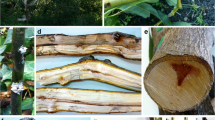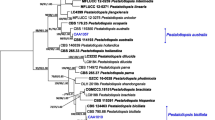Abstract
Background
Crown and root rot is the most important and destructive strawberry diseases in Korea as it causes substantial economic loss. In August 2020, a severe outbreak of crown and root rot on strawberries (Fragaria × ananassa Duch.) was observed in the greenhouse at Sangju, South Korea. Infected plantlets displayed browning rot within the crown and root, stunted growth, and poor rooting.
Methods and results
Thirty fungal isolates were obtained from the affected plantlet. Isolates were identified based on morphological characteristics and pathogenicity test as well as sequence data obtained from internal transcribed spacer, large subunit ribosomal ribonucleic acid, translation elongation factor, and RNA polymerase II-second largest subunit. Results showed that the crown and root rot of strawberry in Korea was caused by three distinct fungal species: Fusarium oxysporum f. sp. fragariae, F. solani, and Plectosphaerella cucumerina. To the best of our knowledge, F. solani, and P. cucumerina are reported for the first time as the causal agents of the crown and root rot of strawberry in South Korea. Pathogenicity tests confirmed that these isolates are pathogenic to strawberry.
Conclusions
Understanding the composition and biology of the pathogen population will be helpful to provide effective control strategies for the disease.






Similar content being viewed by others
Data availability
Resulting sequences have been deposited to GenBank, with accession numbers provided in Supplementary Table 2.
Code availability
Not applicable.
References
Wei H, Liu C, Ryong Jeong B (2020) An Optimal Combination of the Propagation Medium and Fogging Duration Enhances the Survival, Rooting and Early Growth of Strawberry Daughter Plants. Agronomy 10:557
Fang X, Phillips D, Verheyen G, Li H, Sivasithamparam K, Barbetti M (2012) Yields and resistance of strawberry cultivars to crown and root diseases in the field, and cultivar responses to pathogens under controlled environment conditions. Phytopathologia Mediterranae 51:69–84
Gilardi G, Bergeretti F, Gullino ML, Garibaldi A (2019) First Report of Neopestalotiopsis clavispora Causing Root and Crown Rot on Strawberry in Italy. Plant Dis 103:2959
Surovy MZ, Kabir MK, Gupta DR, Hassan O, Mahmud NU, Sabir AA, Rahman M, Chang T, Panaccione DG, Islam MT (2019) First report of Fusarium wilt caused by Fusarium oxysporum on strawberry in Bangladesh. Plant Dis 103:367–368
Zhan, Y.J., Peng, W.J., Xu, Z.Q., Xu, H. & Feng, X.H. First Report of Phytopythium helicoides Causing Root and Crown Rot on Strawberry in China. Plant disease, 104,2528.
Geiser DM, Jiménez-Gasco M, Kang S, Makalowska I, Veeraraghavan N, Ward TJ, Zhang N, Kuldau GA, O’Donnell K (2004) FUSARIUM-ID vol 1.0: A DNA sequence database for identifying Fusarium. Eurrpean Journal of Plant Pathology 110:473–479
Park, K., Han, I., Lee, S.-M., Choi, S.-L., Kim, M. C. & Lee, H. (2019). Crown and Root Rot of Strawberry Caused by Neopestalotiopsis clavispora in Korea. The Korean Journal of Mycology, 47, 427–435. (Abstract in English).
Fang XL, Phillips D, Li H, Sivasithamparam K, Barbetti MJ (2011) Severity of crown and root diseases of strawberry and associated fungal and oomycete patho- gens in Western Australia. Australas Plant Pathol 40:109–119
KSPP (2009) The Korean Society of Plant Pathology. List of plant diseases in Korea, 5th edn. Korean Society of Plant Pathology, Seoul
Kwon JH, Choi O, Kim J (2013) Fusarium oxysporum Causing Wilt and Stem Rot in Chrysanthemum × morifolium in Korea. Plant Dis 97:1118
Stewart JE, Kim M-S, James RL, Dumroese RK, Klopfenstein NB (2006) Molecular characterization of Fusarium oxysporum and Fusarium commune isolates from a conifer nursery. Phytopathology 96:1124–1133
Taylor JW, Jacobson DJ, Kroken S, Kasuga T, Geiser DM, Hibbett DS, Fisher MC (2000) Phylogenetic species recognition and species concepts in fungi. Fungal genetics and biology : FG & B 31(1):21–32
O’Donnell K, Ward TJ, Robert VARG, Crous PW, Geiser DM, Kang S (2015) DNA sequence-based identification of Fusarium: Current status and future directions. Phytoparasitica 43:583–595
Hellin P, Scauflaire J, Van Hese V, Munaut F, Legrève A (2017) Sensitivity of Fusarium culmorum to triazoles: impact of trichothecene chemotypes, oxidative stress response and genetic diversity. Pest Manag Sci 73(6):1244–1252
Ramdial H, De Abreu K, Rampersad SN (2017) Fungicide Sensitivity among Isolates of Colletotrichum truncatum and Fusarium incarnatum-equiseti Species Complex Infecting Bell Pepper in Trinidad. The Plant Pathology Journal 33:118–124
Lombard L, Sandoval-Denis M, Lamprecht SC, Crous PW (2019) Epitypification of Fusarium oxysporum clearing the taxonomic chaos. Persoonia 43:1–47
Maryani N, Lombard L, Poerba YS, Subandiyah S, Crous PW, Kema GHJ (2019) Phylogeny and genetic diversity of the banana Fusarium wilt pathogen Fusarium oxysporum f. sp. cubense in the Indonesian centre of origin. Stud Mycol 92:155–194
Šišić, A., Al-Hatmi, A., Baćanović-Šišić, J., Ahmed, S. A., Dennenmoser, D., de Hoog, G. S. and Finckh, M. R. (2018). Two new species of the Fusarium solani species complex isolated from compost and hibiscus (Hibiscus sp.). Antonie van Leeuwenhoek, 111(10), 1785–1805.
Zhang ZY, Chen WH, Zou X, Han YF, Huang JZ, Liang ZQ, Deshmukh SK (2019) Phylogeny and taxonomy of two new Plectosphaerella (Plectosphaerellaceae, Glomerellales) species from China. MycoKeys 57:47–60
Tamura, K., Stecher, G., Peterson, D., Filipski, A. & Kumar, S. (2013). MEGA6: Molecular Evolutionary Genetics Analysis Version 6.0. Molecular biology and evolution, 30(12), 2725–2729.
Maddison, W. P. and Maddison, D. R. (2011). Mesquite: a modular system for evolutionary analysis. Version 2.75. http://mesquiteproject.org.
Nylander, J. A. A. (2004). MrModelTest v2. Program Distributed by the Author. Uppsala, Sweden: Evolutionary Biology Centre, Uppsala University.
Ronquist, F., Teslenko, M., van der Mark, P., Ayres, D.L., Darling, A., Höhna, S., Larget, B., Liu, L., Suchard, M. A. & Huelsenbeck, J.P. (2012). MrBayes 3.2: efficient Bayesian phylogenetic inference and model choice across a large model space. Systematic biology, 61(3), 539–542.
Cho, C.T. & Moon, B.J.(1984). Studies on the Wilt of Strawberry Caused by Fusarium oxysporum f. sp. fragariae in Korea. Korean Journal of Plant Protection, 23,74–81. (Abstract in English).
Chang X, Dai H, Wang D, Zhou H, He W, Fu Y, Ibrahim F, Zhou Y, Gong G, Shang J, Yang J, Wu X, Yong T, Song C, Yang W (2018) Identification of Fusarium species associated with soybean root rot in Sichuan Province, China. Eurrpean Journal of Plant Pathology 151:563–577
Carlucci A, Raimondo ML, Santos J, Phillips AJ (2012) Plectosphaerella species associated with root and collar rots of horticultural crops in southern Italy. Persoonia 28:34–48
Riley MB, Williamson MR, Maloy O (2002) Plant disease diagnosis. The Plant Health Instructor. https://doi.org/10.1094/PHI-I-2002-1021-01
Chung PC, Wu HY, Wang YW, Ariyawansa HA, Hu HP, Hung TH, Tzean SS, Chung CL (2020) Diversity and pathogenicity of Colletotrichum species causing strawberry anthracnose in Taiwan and description of a new species Colletotrichum miaoliense sp. nov. Scientific Report 10:14664
Palm ME, Gams W, Nirenberg HI (1995) Plectosporium, a new genus for Fusarium tabacinum, the anamorph of Plectosphaerella cucumerina. Mycologia 87:397–406
Dongzhen F, Xilin L, Xiaorong C, Wenwu Y, Yunlu H, Yi C, Jia C, Zhimin L, Litao G, Tuhong W, Xu J, Chunsheng G (2020) Fusarium Species and Fusarium oxysporum Species Complex Genotypes Associated With Yam Wilt in South-Central China. Front Microbiol 11:1964
Hassan O, Jeon JY, Chang T, Shin JS, Oh NK (2018) Molecular and morphological characterization of Colletotrichum species in the Colletotrichum gloeosporioides complex associated with persimmon anthracnose in South Korea. Plant Dis 102:1015–1024
Weir BS, Johnston PR, Damm U (2012) The Colletotrichum gloeosporioides species complex. Stud Mycol 73:115–180
Doohan FM, Brennan J, Cooke BM (2003) Influence of climatic factors on Fusarium species pathognic to cereals. Eurrpean Journal of Plant Pathology 109:755–768
Gilardi, G., Ortu, G., Gullino, M. L. & Garibaldi, A. 2012. Plectosphaerella cucumerina: a new pathogen on wild rocket in Italy. Protezione dele Colture, 5, 31–33. (Summary in English).
Burkhardt A, Henry PM, Koike ST, Gordon TR, Martin F (2019) Detection of Fusarium oxysporum f. sp. fragariae from Infected Strawberry Plants. Plant Dis 103:1006–1013
Nam MH, Kim HS, Park MS, Min JY, Kim HT (2020) Genetic Diversity, Pathogenicity, and Fungicide Response of Fusarium oxysporum f. sp. fragariae Isolated from Strawberry Plants in Korea. Research in Plant Disease 26:79–87
Pastrana AM, Watson DC, Gordon TR (2019) Transmission of Fusarium oxysporum f. sp. fragariae Through Stolons in Strawberry Plants. Plant Dis 103:1249–1251
Han KS, Lee SC, Han YK, Kim DH, Kim S (2012) Crown and Foot Rot of Grafted Cucumber Caused by Fusarium solani f. sp. cucurbitae. Research Plant Disease 18:57–61
Kwon, S. K., Jeon, C.W. & Kwak, Y. S. (2020). First Report of Wilt Disease on Peucedanum japonicum and Selection of Fungicides. The Korean Journal of Pesticide Science, 24, 7–13. (Abstract in English).
Yang JW, Nam SS, Lee HU, Choi KH, Hwang SG, Paul NC (2018) Fusarium root rot caused by Fusarium solani on sweet potato (Ipomoea batatas) in South Korea. Canadian Journal of Plant Patholology 40:90–95
Pastrana AM, Capote N, De Los Santos B, Romero F, Basallote-Ureba MJ (2014) First Report of Fusarium solani Causing Crown and Root Rot on Strawberry Crops in Southwestern Spain. Plant Dis 98:161–161
Abad P, Pérez A, Marqués MC, Vicente MJ, Bruton BD, García-Jiménez J (2000) Assessment of vegetative compatibility of Acremonium cucurbitacearum and Plectosphaerella cucumerina isolates from diseased melon plants. Bulletin OEPP 30(2):199–204
Li PL, Chai AL, Shi YX, Xie XW, Li BJ (2017) First Report of Root Rot Caused by Plectosphaerella cucumerina on Cabbage in China. Mycobiology 45:110–113
O’Donnell K, Sutton DA, Rinaldi MG, Sarver BA, Balajee SA, Schroers HJ, Summerbell RC, Robert VA, Crous PW, Zhang N, Aoki T, Jung K, Park J, Lee YH, Kang S, Park B, Geiser DM (2010) Internet-accessible DNA sequence database for identifying fusaria from human and animal infections. J Journal of clinical microbiology 48:3708–3718
Rehner SA, Samuels GJ (1994) Taxonomy and phylogeny of Gliocladium analysed from nuclear large subunit ribosomal DNA sequences. Mycol Res 98:625–634
Vilgalys R, Hester M (1990) Rapid genetic identification and mapping of enzymatically amplified ribosomal DNA from several Cryptococcus species. J Bacteriol 172(8):4238–4246
White TJ, Bruns T, Taylor J (1990) Amplification and direct sequencing of fungal ribosomal RNA genes for phylogenetics. In: Innis MA, Gelfand DH, Sninsky JJ et al (eds) PCR protocols: a guide to methods and applications. Academic Press, San Diego, pp 315–322
Acknowledgements
We would like to thank all the members of the plant pathology lab, Kyungpook National University, for their valuable support during this study.
Funding
Self funded (Funded by Taehyun Chang).
Author information
Authors and Affiliations
Corresponding author
Ethics declarations
Conflict of interest
The authors declare no conflicts of interest.
Animals rights
There was no involvement of Human Participants and/or Animals in this research.
Informed consent
Not applicable.
Additional information
Publisher's Note
Springer Nature remains neutral with regard to jurisdictional claims in published maps and institutional affiliations.
Supplementary Information
Below is the link to the electronic supplementary material.
Rights and permissions
About this article
Cite this article
Hassan, O., Chang, T. Morphological and molecular characteristics of fungal species associated with crown rot of strawberry in South Korea. Mol Biol Rep 49, 51–62 (2022). https://doi.org/10.1007/s11033-021-06841-9
Received:
Accepted:
Published:
Issue Date:
DOI: https://doi.org/10.1007/s11033-021-06841-9




